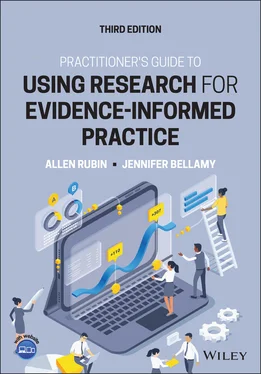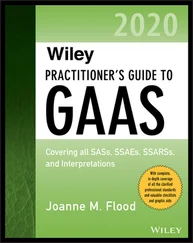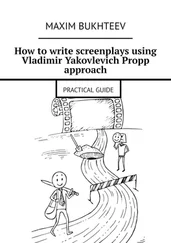1 Brownson, R. C., Baker, E. A., Leet, T. L., & Gillespie, K. N. (2003). Evidence-informed public health. Oxford University Press.
2 Dallas Morning News. (1990, February 11). Welfare study withholds benefits from 800 Texans, p. 1.
3 Drake, R. E., Merrens, M. R., & Lynde, D. W.. (Eds.) (2005). Evidence-informed mental health practice: A textbook. Norton.
4 Gambrill, E. (2005). Critical thinking in clinical practice (2nd ed.). Wiley.
5 Gibbs, L. E. (2003). Evidence-informed practice for the helping professions. Brooks/Cole.
6 Haynes, R., Devereaux, P., & Guyatt, G. (2002). Physicians' and patients' choices in evidence based practice: Evidence does not make decisions, people do. British Medical Journal, 324, 1350.
7 Jackson, C. A. (1998). Evidence-informed decision-making for community health programs. Rand.
8 Jones, J. H. (1981). Bad blood: The tuskegee syphilis experiment. Free Press.
9 Lwin, K., & Beltrano, N. (2020). Rethinking evidence-based and evidence-informed practice: A call for evidence-informed decision making in social work education and child welfare practice. Social Work Education, 1–9.
10 Milgram, S. (1963). Behavioral study of obedience. Journal of Abnormal and Social Psychology, 67, 371–378.
11 Milgram, S. (1965). Some conditions of obedience and disobedience to authority. Human Relations, 18, 57–76.
12 Muir Gray, J. A. (2001). Evidence-informed healthcare: How to make health policy and management decisions (2nd ed.). Churchill-Livingstone.
13 Norcross, J. C., Beutler, L. E., & Levant, R. F.. (Eds.) (2006). Evidence-informed practices in mental health: Debate and dialogue on the fundamental questions. American Psychological Association.
14 O'Hare, T. (2005). Evidence-informed practices for social workers: An interdisciplinary approach. Lyceum Books.
15 Roberts, A. R., & Yeager, K. R.. (Eds.) (2004). Evidence-informed practice manual: Research and outcome measures in health and human services. Oxford University Press.
16 Sanderson, I. (2002). Evaluation, policy learning and evidence-based policy making. Public Administration, 80(1), 1–22.
17 Satterfield, J., Spring, B., Brownson, R. C., Mullen, E., Newhouse, R., Walker, B., & Whitlock, E. (2009). Toward a transdisciplinary model of evidence-based practice. Milbank Quarterly, 87(2), 368–390.
18 Strauss, S. E., Richardson, W. S., Glasziou, P., & Haynes, R. B. (2005). Evidence-informed medicine: How to practice and teach EBM (3rd ed.). Elsevier.
19 Tufford, L., Newman, P. A., & Woodford, M. R. (2012). Conducting research with lesbian, gay, and bisexual populations: navigating ethics board reviews. Journal of Gay and Lesbian Social Services, 24, 221–240.
20 Williams, J. B. W., & Ell, K. W. (1998). Advances in mental health research: Implications for practice. NASW Press.
2 Steps in the EIP Process
1 2.1 Step 1: Question Formulation
2 2.2 Step 2: Evidence Search 2.2.1 Some Useful Websites 2.2.2 Search Terms 2.2.3 An Internet Search Using Google Scholar and PsycINFO 2.2.4 A Time-Saving Tip
3 2.3 Step 3: Critically Appraising Studies and Reviews
4 2.4 Step 4: Selecting and Implementing the Intervention 2.4.1 Importance of Practice Context 2.4.2 How Many Studies Are Needed? 2.4.3 Client-Informed Consent
5 2.5 Step 5: Monitor Client Progress
6 2.6 Feasibility Constraints 2.6.1 Strategies for Overcoming Feasibility Obstacles
7 2.7 But What about the Dodo Bird Verdict? Key Chapter Concepts Review Exercises Additional Readings
As is discussed in Chapter 1, various authors have recommended a number of steps in the evidence-informed practice (EIP) process. Although not all authors agree on the exact number of steps and how to label them, they generally agree that the number is around five or six. More important, there is wide agreement as to what is to be done overall, regardless of the number of steps used to order them. In this chapter, five main steps in the EIP process are discussed in more detail. The chapter ends with a discussion of various daunting feasibility constraints that you are likely to encounter in trying to implement these EIP steps in the real world of practice.
2.1 Step 1: Question Formulation
Before you start searching for evidence, you need to know what question you are trying to answer. Chapter 1describes six common types of EIP questions. One of the most common of the six questions pertains to ascertaining which interventions, programs, or policies have the best evidence supporting their effectiveness.
Suppose, for example, that you are planning to establish a residential treatment facility for physically or sexually abused girls who have emotional or behavioral problems, and you need to decide which treatment modalities to employ. Your EIP question might inquire as to which treatment modalities have the best evidence supporting their effectiveness with girls who share the projected characteristics of your clients. Alternatively, you might have reason in advance to suspect that one or more particular modalities will be most effective based on what you have read or heard about it from a theoretical standpoint. For example, colleagues involved in a similar program elsewhere might rave about the great success they've experienced using eye movement desensitization and reprocessing (EMDR). Colleagues in another program might claim to have had little success with EMDR and much more success with exposure therapy. Perhaps you've read clinical books on both modalities, and both look equally promising to you from a clinical standpoint. Consequently, instead of asking a broader question about the effectiveness of the gamut of possible treatment modalities, you might narrow your search to the question of whether EMDR or exposure therapy is more effective with the types of clients you plan to treat.
A tool that you might choose to use to construct your question about effectiveness or about which assessment tool to use is the PICO (patient/population, intervention, comparison and outcomes) framework. PICO questions include four parts, which are represented by the four letters in the acronym, as illustrated in Table 2.1. Writing a question using this PICO framework can help you clearly articulate your question and help you to develop search terms that capture each of these important elements.
Before you begin to search the evidence, it can be helpful to lay out your question – whether you are using a PICO framework or not – so that you can think about the key search terms that you could use before you are in the thick of the search. Especially helpful is to think about synonyms that represent the same key concepts in your question. For example, different studies might refer to children aged 12–16 as children, youth, or young adolescents. If you don't think about these synonyms, you may miss studies that just use different language to mean the exact same thing.
2.2 Step 2: Evidence Search
There are various ways to search for evidence related to your practice question. You could, for example, conduct an exhaustive literature search in a scholarly fashion. Unless you are currently a student, however, your busy practice demands probably don't leave enough time for that. Moreover, you probably lack access to some of the resources that students and academicians have, such as a university library and a research librarian (not to mention significant time to spend there) or a subscription to expensive professional literature databases. Fortunately, if you have access to a more popular search engine such as Google, Yahoo!, or Bing, you might find some of the evidence you need there. For example, if you enter the search term exposure therapy or EMDR, Google, Yahoo!, or Bing will list a large number of links to websites on those treatment modalities.
Читать дальше












